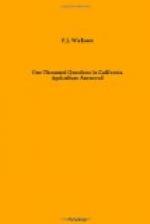We doubt the profit of feeding whole grain to hogs of any age while on green pasture. On almost all kinds of land they will get enough grit to keep their teeth sore, hence they will not masticate the grain thoroughly. Perfect mastication is very essential. We would feed the pigs all the slop that they would clean up good twice a day. The slop to be composed of equal parts of corn, barley meal ground fine, and wheat middlings mixed with milk. There is nothing in all the world like milk for growing pigs. If milk is not to be had, we would add from 5 to 10 per cent meat meal, which we consider next to milk. If whole grain is to be used, it should be thoroughly cooked on account of the pigs’ teeth not being in condition to chew the hard grain. — Chas. Goodman.
Growing Pigs on Roots and Barley.
We can raise all kinds of root crops, such as carrots, sugar beets, rutabagas, etc., and cow peas and pumpkins do wonderfully well. Will hogs do well an that kind of diet, especially if given a little barley with it?
The plants that you mention are good for hog feeding and can be used to advantage with a little barley as you suggest. None of these plants are, however, rich in protein as alfalfa and the other clovers are. The reason why we get such a rapid and satisfactory growth of young hogs in California is due to the fact that they are largely kept on alfalfa and rapid growth is the product of a sufficient protein content in the fodder. Both common field peas and cowpeas do not possess this element, and if you can grow them they will serve as a substitute for the other legumes, such as alfalfa. If you are feeding skim-milk, which is rich in protein, roots and grain will go well with that.
Wheat and Barley for Feeding.
What is the difference in the feeding value of wheat and barley for hogs and horses?
There is very little difference in the chemical composition of wheat and barley. In their physical condition there is much difference, chiefly because of the adhering chaff of the barley, which makes it more digestible because it separates the starchy mass and enables the gastric juice to work upon the particles more readily and quickly. Oats also have this character. This is very important in the case of horses, which can quickly be put out of condition by feeding wheat. For hogs and chickens it makes much less difference, and the absence of the chaff gives a greater amount of nutritive matter to the ton, so that wheat is worth more at the same ton price. But look out about giving horses too much wheat.
Part VII. Diseases of Animals
This division is largely compiled from the writings of Dr. E. J. Creely of the San Francisco Veterinary College.
Abscess of Parotid Gland.
My horse has had a bad cold and it has a large lump on its neck which keeps running and does not seem to get any better; it has been running for two weeks.




